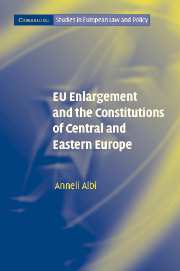Book contents
- Frontmatter
- Contents
- List of tables
- Series Editors' Preface
- Acknowledgements
- Table of cases
- Table of treaties, laws and other instruments
- List of abbreviations
- Introduction
- 1 Overview of the accession process
- 2 Constitutional adaptations in the ‘old’ Member States
- 3 Some idiosyncrasies of CEE constitutions
- 4 Constitutional issues in the pre-accession period
- 5 Revision of CEE constitutions for EU membership
- 6 Theoretical views of sovereignty and democratic legitimacy in CEE
- 7 Referendums
- 8 Membership of NATO and other international organisations
- 9 Role of Constitutional Courts
- 10 Implications of the European Constitution
- Epilogue: ‘Taking constitutions seriously’ in the process of European integration
- Bibliography
- Appendix
- Index
8 - Membership of NATO and other international organisations
Published online by Cambridge University Press: 28 July 2009
- Frontmatter
- Contents
- List of tables
- Series Editors' Preface
- Acknowledgements
- Table of cases
- Table of treaties, laws and other instruments
- List of abbreviations
- Introduction
- 1 Overview of the accession process
- 2 Constitutional adaptations in the ‘old’ Member States
- 3 Some idiosyncrasies of CEE constitutions
- 4 Constitutional issues in the pre-accession period
- 5 Revision of CEE constitutions for EU membership
- 6 Theoretical views of sovereignty and democratic legitimacy in CEE
- 7 Referendums
- 8 Membership of NATO and other international organisations
- 9 Role of Constitutional Courts
- 10 Implications of the European Constitution
- Epilogue: ‘Taking constitutions seriously’ in the process of European integration
- Bibliography
- Appendix
- Index
Summary
NATO
In the wake of regime change, the countries of Central and Eastern Europe have also become members of various other international organisations. In terms of the strict protection of sovereignty in the CEE constitutions, the participation in the North Atlantic Treaty Organisation (NATO) is of particular interest. The Czech Republic, Hungary and Poland joined NATO in 1999; Slovakia, Slovenia, Romania, Bulgaria and the Baltic countries received their invitation to join in the autumn of 2002.
The main restrictions on a state's sovereign action by membership of NATO could be summarised as follows. As regards autonomy of external action, the state is constrained in making decisions upon war – it has to join in collective defence in the event of an aggression against one of the allied countries, under the North Atlantic Treaty concluded in 1949 in Washington. In terms of inviolability of state borders, a NATO member has to grant the right of passage or manoeuvre to certain foreign troops within its territory. In financial terms, a member country has an obligation to spend at least 2 per cent of its budget on defence. In addition, the need for fast decision-making effectively means that cumbersome and lengthy parliamentary decisions are to be replaced by the speedier decisions of domestic governments. Overall, however, membership of NATO has predominantly not been perceived as a restriction of sovereignty in the political rhetoric or constitutional theory of most CEE countries – on the contrary, it has formed a long-standing foreign policy goal and a key guarantee for the countries' security.
- Type
- Chapter
- Information
- Publisher: Cambridge University PressPrint publication year: 2005



